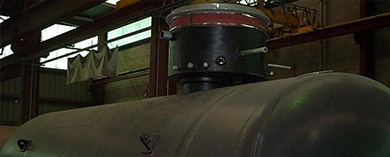
- (03) 5909 8218
- enquiry@fusionweld.com.au
Custom-Built Debutanizer Vessels
November 6, 2014

The oil and gas industry both employ complex chemical processing exchanges. Pressure and temperature changes, the addition of cracking catalysts, and the extraction of evaporated or distilled chemical products create a vast laboratory. That chemistry lab cooks organic products, and the immense kitchen or lab, we'll try and avoid mixing our metaphors, covers acres of land with masses of high-tensile steel. We all know of the purpose of this spaghetti junction of pipes and pressure vessels, the science used to extract useful fuels and synthetics from the oil and gas, but the science and scale behind separating these hydrocarbons is unbelievably intricate. Distillation is a key part of this model of operation, and the debutanizer column, as the name suggests, specializes in splitting butane from the other components present in natural gas liquids. Propane, butane, ethane, these gases all belong to alkane families where carbon atoms and hydrogen atoms bond in interesting and energetic ways. By using fractional distillation, chemical engineers separate the gaseous components of these alkanes into discrete substances.
Oil refineries and standalone fractional distillation complexes create a unique skyline of tall columns. These are downstream distillation towers, vessels that appear in groups of two or three. They're classed depending on the natural gas product each one is designed to distil. For example, a group of three columns puncturing the skyline is likely designed to take a natural gas stream and split the heavy hydrocarbons from the gas. Twenty-four hours a day, seven days a week, the gas stream flows into these vessels. Ethane, propane, and butane are fractionally separated here, split and delivered to storage vessels. While this fractional train is a straightforward concept involving the division of heavier molecules from lighter variants, the engineering principles that constitute the vessel design are more demanding. Customized builds arise from client-defined dimensions. Safety features and insulation materials enter the design criteria, with ISO certified codes aligning to regulate ASME boiler and pressure stipulations.
The debutanizer distillation tower was chosen for this document because it steps in at the end of the train, coming after the deethanization and depropanization process. The removal of the butane from the natural gas leaves nothing but heavier hydrocarbons and some minor members of the alkane family, pentane and octane are among them. A secondary stage can be incorporated into the fractional removal of butane, a sub-process that splits isobutane, but the model of fractionation remains inherently consistent. Regardless of the order of the work, the progression from tower-to-tower to distil and separate organic molecules, it's worth noting that this breaking down action is now being replicated by innovative modular units, skids that have been pre-assembled and tested to carry out the fractionation work with greater versatility.
Contact Details
Fusion - Weld Engineering Pty Ltd
ABN 98 068 987619
1865 Frankston Flinders Road,
Hastings, VIC 3915
Ph: (03) 5909 8218
Optimized by NetwizardSEO.com.au
Recent Posts
- Heat Exchanger Maintenance in Melbourne: Minimising Risk in Power Generation Facilities
- Compressed Hydrogen Storage Vessels: Material Selection, Design & Australian Standards
- Welding QA/QC in Oil & Gas Pressure Vessel Fabrication – Ensuring Code Compliance
- AS1210 vs ASME VIII Pressure Vessel Code: Key Differences for Australian Projects
- Mitigating Hydrogen-Induced Cracking in Pressure Vessels: Engineering and Material Strategies
- Storage Tank Solutions Australia: Field-Erected, Prefabricated & Self-Bunded Explained
- Reducing Environmental Risks: Self-Bunded Tanks in Australian Oil & Gas Operations
- Precision in Production: How Pressure Vessels Are Manufactured for Industrial Safety
- Shell & Tube Heat Exchangers: Improve Thermal Control & Energy Recovery in Petrochemical & Pharmaceutical Plants
- In-Service Inspection for Compressed Air Receivers for Power Plant Shutdown Prevention
- Power Plant Pipe Spooling Fabrication – Get Rapid, Code-Compliant Spools Ready for Installation
- Field Erected Tanks: Safe, Reliable On-Site Fuel Storage Solutions in Australia
Posts 2026
- Heat Exchanger Maintenance in Melbourne: Minimising Risk in Power Generation Facilities
- View all articles…
Posts 2025
- Compressed Hydrogen Storage Vessels: Material Selection, Design & Australian Standards
- Welding QA/QC in Oil & Gas Pressure Vessel Fabrication – Ensuring Code Compliance
- View all articles…
Posts 2024
- Large Process Vessels: Optimising the Design for Maximum Efficiency [2025]
- Pressure Equipment Management System Installation: Detect Equipment Faults Early
- View all articles…
Posts 2023
- Pressure Piping System Inspection: A Gift of Safety for the Holidays
- Deaerator Inspections by Fusion-Weld Engineering and How They Reduce System Downtime
- View all articles…
Posts 2022
- How Fusion Weld Keeps Up With AS-NZS ISO 9001:2008 Standard
- Boiler Equipment Safety Inspection During the Summer Season
- View all articles…
Posts 2021
- Avoid These Factors and Practices that Contribute to Sealing Damage in Pressure Vessels
- Do's And Don'ts Of Industrial Boiler Inspection And Maintenance From Fusion-Weld
- View all articles…
Posts 2020
- What are the Risks and Hazards Involved in Pressure Vessel Equipment?
- How to Know if Your Pressure Equipment Needs Repair or Replacement?
- View all articles…
Posts 2019
- Factors that Contribute to Pressure Vessel Failure
- Pressure Vessel Regulations in Australia: What are the Mandatory Requirements?
- View all articles…
Posts 2018
- Pros and Cons of Spherical vs. Cylindrical Pressure Vessels
- What are the Different Hazard Levels in Pressure Vessels?
- View all articles…
Posts 2017
- Transportable Pressure Vessels: The Importance of Inspection and Safety Checks
- Fracture Mechanics and Stress Analysis of Cracks in Pressure Vessels
- View all articles…
Posts 2016
Posts 2015
- What Are Deaerators & Feedwater Vessels?
- Precautions and Safety for Compressed Air Receiver Vessels
- View all articles…
Posts 2014
- Demonstrating In-process Inspection Procedures
- Static Grounding Practices and Standards
- View all articles…